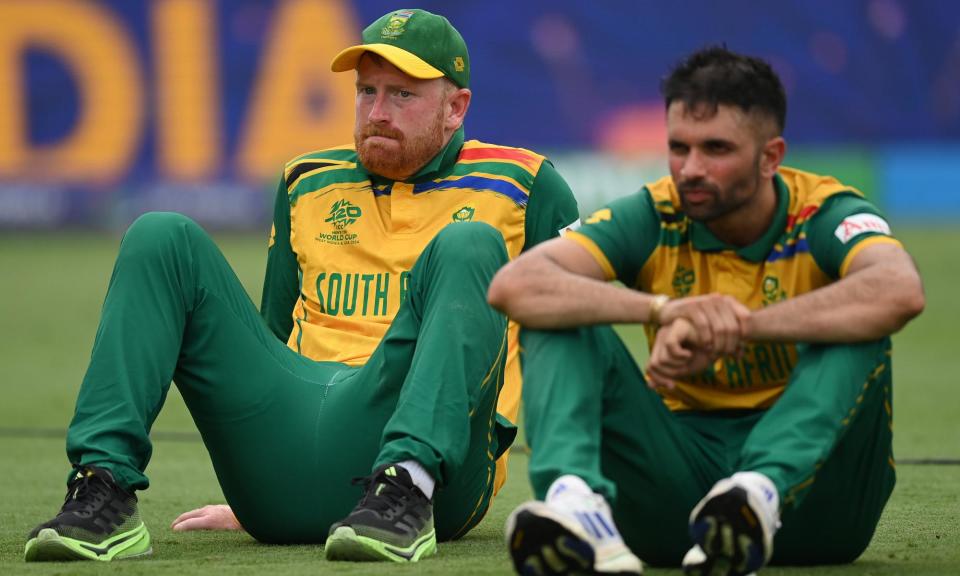South Africa’s World Cup agony was no choke, with hope for future glory

What was on Keshav Maharaj’s mind as Jasprit Bumrah ran in to deliver the final ball of the 18th over in South Africa’s run chase on Saturday? Was he thinking about Allan Donald’s dropped bat in 1999, or the rain in Durban in 2003, or Grant Elliott’s game-winning knock in 2015? Did any of the Proteas’ near-misses and howlers at World Cups enter the South Africa spinner’s consciousness?
I doubt it. I bet that if you asked Maharaj what his name was just as the best all-format bowler on the planet began his staccato run-up, he’d have struggled to give you an answer. I bet that behind his wide startled eyes his one and only thought would have zeroed in on survival.
This is important for two reasons. Firstly it was at this precise moment where South Africa lost the T20 World Cup final to India. Maharaj prodded forward and instinctively set off for a run after poking the ball into the covers. This meant that David Miller, South Africa’s last recognised batter, would be off strike for the start of the 19th over with 20 still required for victory. That Bumrah ball to Maharaj also matters when assessing whether or not the Proteas, once again, as a collective, choked.
Related: South Africa’s search for absolution continues as Kohli finds formula
There it is. The C word. A tag now synonymous with a team that has produced players in contention for the best white ball batter of all time, the best seamer of all time and the most successful Test captain in history. And until the Proteas back up their potential with a World Cup title, it is a tag that will continue to hang heavy around their necks.
But here’s the thing. Apart from Maharaj’s terror-induced lapse, where he acted in a way that was a direct consequence of a clouded mind, no other mistake committed by a South African could be classified as a choke. Across the 221 deliveries that preceded this event, and the 18 deliveries that followed it, no one else in gold and green lost their heads.
Sure there were mistakes. Marco Jansen was sloppy with the new ball, Aiden Markram fished at a wide one and nicked off, Quinton de Kock picked out a fielder with a shot he normally spanks over the rope, Heinrich Klaasen was suckered into swiping at a disguised slower ball and Miller failed to hit a low full toss for six. But these were cricketing incidents. Every close game has a dozen that turn the tide. To label every narrow defeat, even those where winning was a strong possibility, as a choke is lazy and reductive, like branding anyone who believes in free healthcare an ardent Maoist. Furthermore, it diminishes the role of the opposition in taking back control of a game that was theirs to lose from the start.
Let’s briefly linger on India. Bumrah is what the kids call a cheat-code. Virat Kohli is a genius. Their spinners are necromancers. Shivam Dube, a man that many self-identifying cricket fans had never heard of before the tournament, thwacks sixes into orbit. Were it not for a staggering capitulation to Australia in last year’s 50-over World Cup final – a bonafide choke on India’s part – Rohit Sharma would be in possession of both white ball titles and his side universally regarded as one of the best ever assembled.
India obliterated England, hammered Australia and blew away every other side that had the temerity of sharing a field with them at this World Cup. They set South Africa a score that would have been a record chase at the Kensington Oval as well as a record chase in a T20 World Cup final. And even though the WinViz predictor gave South Africa close to a 45% chance of hauling in their target at the top of their innings, 177 against that attack was always going to be a tough ask.
They got close because they defied expectations, because they landed shots against India’s previously untouchable slow bowlers and because Tristan Stubbs, a 23-year-old with only two years’ experience at the highest level, held firm when promoted up the order to number three. Then Klaasen scored the fastest half century in a final off 23 balls with strokes that defied logic. None of it made sense. This wasn’t supposed to be a contest. That we had one is a testament to South Africa’s ability to not choke in the biggest game of their lives.
There’s every reason to believe that this current crop could end the cycle of pain. With a white ball World Cup coming round every two years, and with scarcely any Test cricket on the horizon to fatigue legs and minds, there is hope that under Markram this group has the tools for another tilt at glory. And with a lucrative domestic league churning out homegrown talent, as well as a constant presence in the IPL, there will be no shortage of able deputies.
Not that the potential of sunshine tomorrow clears away the clouds today. This one hurts, no doubt about it. But if there’s a kernel of comfort, it’s that this time they were not the architects of their own demise. They went toe to toe with a titan, bloodied his nose and almost found a knockout blow. There’s no shame in losing with pride. There is, or at least there should be, shame in reducing that loss to a tired, inaccurate cliche.
This is an extract from the Guardian’s weekly cricket email, The Spin. To subscribe, just visit this page and follow the instructions.

 Yahoo Sport
Yahoo Sport 






































